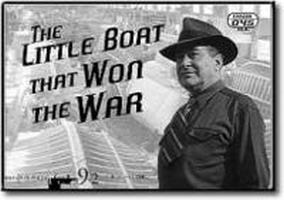 I am aware of only one man who was praised by both Eisenhower and Hitler. A repost on the 77th anniversary of D-Day.
I am aware of only one man who was praised by both Eisenhower and Hitler. A repost on the 77th anniversary of D-Day.
General Dwight David Eisenhower said that “Andrew Higgins … is the man who won the war for us. … If Higgins had not designed and built those LCVPs, we never could have landed over an open beach. The whole strategy of the war would have been different.”
Adolph Hitler referred to Andrew Higgins as the “new Noah,” though his admiration was more begrudging. On the 77th anniversary of the Normandy landings, better known as D-Day, it seems worthwhile to remember Andrew Higgins and the amazing Higgins boat.
Andrew Jackson Higgins was a high school drop-out from Nebraska, who came to New Orleans, Louisiana to get into the timber business. He soon branched out to building boats which operated in the shallow waters of the swamps, hauling out felled trees. Prior to World War II, the Navy’s landing craft were antiquated and cumbersome. Higgin’s design, based on his shallow water workboats, proved superior, despite objections by the Naval Bureau of Construction and Repair. The Marine Corps was a major supporter of the Higgins’ design because it was simply better than anything that the Navy had to offer.
The first boat, dubbed Landing Craft Personnel (Large) or LCP (L), still required the soldiers on board to disembark by jumping over the bow or the sides. Inspired by a Japanese landing craft design, Higgins added a bow ramp to his design, allowing 36 fully equipped soldiers to charge down the ramp onto the beach as soon as the ramp was dropped. The design, dubbed Landing Craft, Vehicle, Personnel (LCVP), but better known simply as the Higgins boat, would change the course of the war, allowing amphibious landings over open beaches without the need to capture deepwater ports. The D-Day landings in Normandy would not have been possible without the Higgins boat.
The Higgins Boats that won WWII
The Higgins boats were only 36′ long with a 10′ beam. They were built of plywood with a steel ramp door. Despite their small size, the boat could carry 36 men or a jeep and 12 men, or 8,000 pounds of cargo. A larger variant, the LCM, Landing Craft Mechanized could carry a tank.
The Higgins boats led amphibious operations including Operation Overlord on D-Day in Nazi German-occupied Normandy, as well as Operation Torch in North Africa, the Allied invasion of Sicily, Operation Shingle and Operation Avalanche in Italy, Operation Dragoon, and in the Pacific Theatre at the Battle of Guadalcanal, the Battle of Tarawa, the Battle of the Philippines, the Battle of Iwo Jima and the Battle of Okinawa.
More than 20,000 Higgins boats were built by Higgins Industries and licensees.

BRITISH D DAY MEMORIAL UNVEILED
https://www.bbc.co.uk/news/uk-57373932
https://www.youtube.com/watch?v=KQgtq_Fssek
https://www.youtube.com/watch?v=7IkZq2m_hSU
Royal Navy
On this day in June 1944, Hitler’s vaunted Atlantic Wall was punctured by the bravery, ingenuity and overwhelming firepower of Allied forces.
Today marks the anniversary of D-Day, the beginning of the liberation of Western Europe from Nazi tyranny under the banner of Operation Overlord and its naval element, Operation Neptune.
Nearly 200,000 naval personnel – more than half of them Royal Navy, plus 25,000 Merchant Navy seaman – manned an invasion force of nearly 7,000 vessels, from battleships and cruisers pounding German positions, through more than 4,000 landing craft and a good 1,500 supporting vessels.
The ring of steel drawn around the invasion fleet, plus Allied air cover – including Fleet Air Arm patrols – largely protected it from the German Navy, but losses in the attacking waves of landing craft were heavy: one fifth of 47 (Royal Marines) Commando was wiped out in the initial assault wave at Gold Beach.
Along the coast at Juno Beach, fellow Royal Marines suffered heavy losses as it stormed and captured the seafront village of Langrune-sur-Mer.
In all upwards of 10,000 men on both sides were casualties on the first day of the invasion; at least 100 sailors and Royal Marines with no known grave are honoured on Portsmouth Naval Memorial alone.
Their sacrifice is also being remembered with the formal dedication of the new Normandy Memorial overlooking what was Gold Beach on June 6 1944.
New patrol ship – freshly painted in ‘dazzle’ camouflage like her sister HMS Tamar – is due to act as guardship for proceedings, stationed in the waters just offshore.
Given the pandemic, veterans and family members/descendants have been invited to an event at the National Memorial Arboretum in Staffordshire where they can watch proceedings and also link up with old comrades.
See – https://www.royalnavy.mod.uk/news-and-l … y-at-d-day
To paraphrase Satre “simplicity is perfection”
A philosophy the modern military have moved away from at their and our expense.
On This Day – Decoys at Woolverstone, on the river Stour in Suffolk, East Anglia, England
77 years ago today, codenamed Operation Overlord, the battle known as D-Day, began. 156,000 American, British and Canadian forces landed on five beaches along a 50-mile stretch of the heavily fortified coast of France’s Normandy region. Prior to D-Day, the Allies conducted a large-scale deception campaign designed to mislead the Germans about the intended invasion target, with fake landing craft and other military equipment in Woolverstone used for this purpose. By late August 1944, all of northern France had been liberated, and by the following spring the Allies had defeated the Germans.
From – https://shotleypeninsula.nub.news/n/sunday39s-peninsula-breakfast-briefing-1622893530?fbclid=IwAR2a4q3gjvHtfEmEXsfR4sjbeK0orilwlzjK1oWD0bx4MufqtOHofWBhC78
The Higgins Family has a summer home up here on Treasure Island.
21st century beach landing?
https://www.facebook.com/watch/?v=1736807883276752
Captain, good to know that the Ford Fiesta’s cup holders are the right size for smoke grenades.